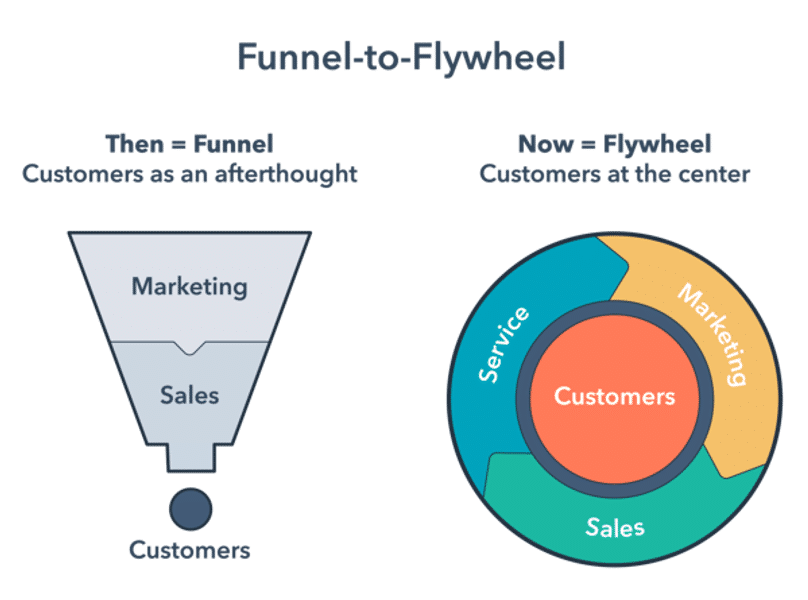Case: How Customer Journey Mapping Helps Strengthen Your Online Channel
(This is a guest post authored by Ralph Wolbrink, co-founder at Pure Internet Marketing)
Online businesses have access to a tonne of customer data, thanks to the plethora of analytics tools available. (It is not just Google Analytics that does the trick)
Unfortunately, data reveals only the symptoms and tells nothing about the subjective experiences of a user. This is where mapping out the customer journey can be of immense help in understanding the customer better and providing value where they require it.
Download Free: Customer Engagement Guide
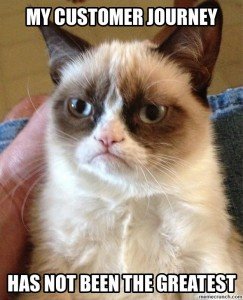
Customer journey is quite simply a storyboard that shows how customers engage with different media, consume information, and make decisions while moving through the different stages of a buying process – awareness to engagement to purchase. Check out this delightfully detailed article on customer journey mapping.
There are various reasons why customer journeys can add a tremendous amount of value to a service. I like to apply a customer journey to activities that fall within the online channel: SEA, SEO, and conversion rate optimization. We created a customer journey for EUclaim in order to establish contact with the customer at the right online moments and also to ease the customer’s experience on the website, both of each ultimately leads to more sales.
EUclaim, established in 2007, is a European market leader when it comes to offering support to long-delayed passengers in terms of their rights. They do this through a combination of investigating delays, submitting claims, and where required, proving in a court of law that a claim is legitimate. As a result of this support, the passenger is then able to successfully claim their right to compensation.
Flight Delays and EUclaim
Delays are all too common in air travel. According to EU regulation 261/2004 passengers are, subject to certain conditions, eligible for financial compensation in case of flight delay. Such compensation applies when passengers arrive too late at their destination due to a delay, denial of boarding, cancellation of flight, or when they miss their connecting flight. Depending on the distance, the compensation that passengers are eligible for is as high as 600 Euros per passenger. Of course, compensation is not applicable to all delays.
The conditions for a legitimate claim are:
- Arriving at one’s destination at least three hours later than planned (two hours in case of cancelled flights)
- No exceptional circumstances (for example weather conditions or strikes)
- Not having been informed about the delay or cancellation at least two weeks in advance
- Not having received an offer to take a different flight in order to ensure on-time arrival at one’s destination.
Experience shows that legitimate claims by delayed passengers are often rejected, with airline companies resorting to “force majeure” in order to avoid settling a claim.
The business model of EUclaim works on the basis of a commission that is paid to the company every time a passenger claim is actually paid out. And they strictly adhere to the “no cure, no pay” model. When a lawsuit against an airline company is not won, the consumer will not bear any of the costs associated with the lawsuit.
The service provided by EUclaim takes place predominantly online. A customer journey has been set up to map the journey taken by the customer and consequently to identify and address as many potential improvements as possible.
Customer Profile
Before the customer journey can be mapped, a profile of the customer (at least in summary form) is needed. Despite there being a number of customer profiles, each with their own unique customer journey, most of the customers who connect with EUclaim fit the following profile:
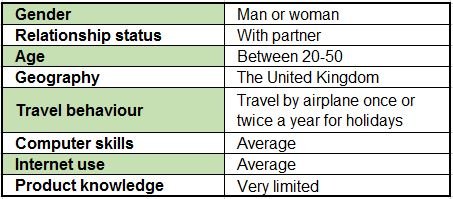
The Customer Journey
The complete customer journey as we researched is quite long and can be found here. For the sake of brevity, I’ll only be touching upon the most important points from the customer journey in this article.
The Journey
Going on holidays is an occasion everyone looks forward to. Before the trip there may be some stress from time to time, but all in all there is excitement because people are going to do something enjoyable (presumably) and they are about to create fantastic memories. However, the traveler has very limited control over the situation should anything go wrong with the flight.
A customer journey is generally a positive experience, until the return flight is confirmed and there seems to be a delay. The behavior is then as follows:

One major problem that passengers have to contend with is a lack of transparency. When a delay occurs, there is often a lack of communication about how long the delay is going to be. There are actually examples of an airplane not yet standing on the right airport, but still the passengers are kept in the dark. It is not clear whether this is caused by wanting to avoid embarrassment, or whether the employee at the counter who is being asked simply does not know. What is clear is that this type of behavior does not help the passenger one bit. The mood of the passenger starts to deteriorate.
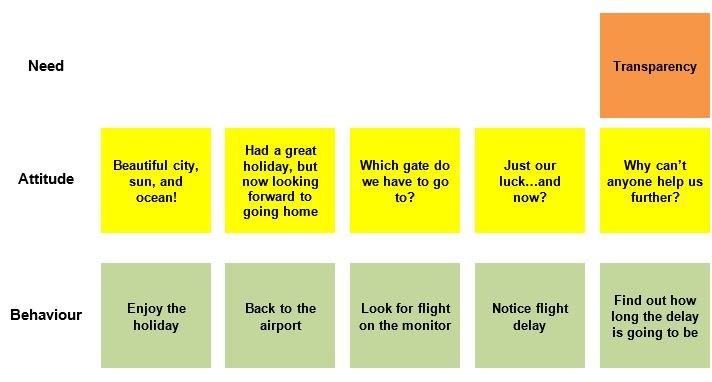
Travelers feel powerless, uninformed, and are in urgent need of clarity. This is, along with loss of luggage, one of the least pleasant ways to conclude a holiday. Passengers have no option but to wait and keep an eye on the screens. And before you know, they are wandering aimlessly around the terminal. They have already exhausted the shopping options in the airport and now all that is left for them is to just browse the internet.
Very soon posts start appearing on social media, with passengers making clear their dissatisfaction and frustration with regards to the delay, as well as the lack of clarity about it from the airline.
Rights of Passengers
The next phase is characterized by long periods of waiting and looking for answers on the internet. Customers want to know what their rights are. The disadvantage to EUclaim when it comes to the provision of this service is that many, many travelers are not familiar at all with the relatively new legislation in this area. As a result a common search term is then simply “flight delayed”.
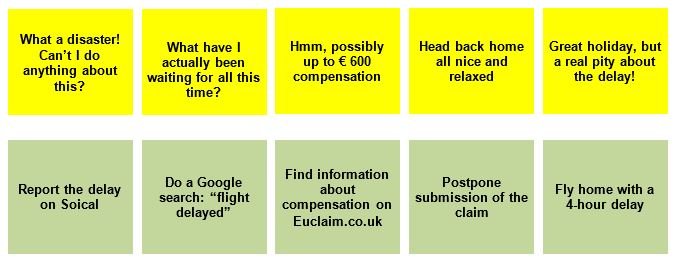
Customers are often unaware that they can claim food, drinks and overnight accommodation. In the case of long delays, they can also claim damage compensation. EUclaim provides this information on its website and offers further support to delayed travelers. It is very important for EUclaim to be visible to travelers already when they are just starting to look for information online. This first possible point of contact with a potential future customer is not to be taken lightly!
In order to be visible at the time of the internet search, SEO must be taken very seriously, but Google AdWords is also used.
Download Free: Customer Engagement Guide
Claim Submission
Upon arrival at home, the customer goes back to life as usual, but still keeps in mind the potential financial compensation. There will therefore be a new search for “flight delayed” or, as in many cases, “euclaim”.
It also often occurs that passengers submit a claim with the airline company themselves. EUclaim also regularly advises delayed travelers to first try submitting a claim themselves. Unfortunately, in very many cases, the complaints of travelers are rejected using a “force majeure” argument, even when this was not the case. It is at that moment that travelers come back to EUclaim.
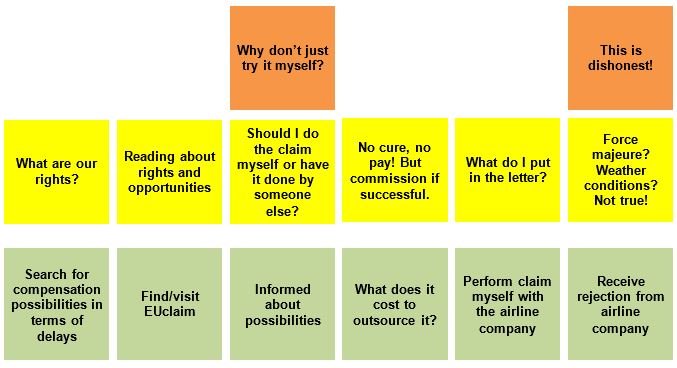
The repeat visit to EUclaim.co.uk once again takes place through Google, even though they then often remember the name. It is therefore again important to be thoroughly visible on Google.co.uk.
When the delayed traveler returns to the EUclaim.co.uk website, their intention is different to what it was before. This visitor now intends to hand the claim over to EUclaim. This is where the wizard becomes crucial for the purpose of winning the trust of the visitor. Reviews are an important means by which to achieve this. Before, EUclaim would collect and post reviews on the site. With regards to the visibility in search engines via rich snippets and in order to prove objectivity, it has now decided to use Trustpilot for this. Customers seem to appreciate the results and functionality of Trustpilot.
The wizard is therefore very important. This is where they get advice regarding the fairness of a claim and get EUclaim officially involved. In other words, this is where a mere visitor can turn into a customer. The wizard comprises four steps:
- The flight information
- The problem (delay, missing of connecting flight, flight cancellation or denial to board)
- The value of the damage compensation that the customer has a right to claim
- The submission of the claim at EUclaim
By referring to the flight number, the date, the type of delay and EUclaim’s own information about flights and external factors, EUclaim now determines whether or not the claim is valid. During this process there are often questions that visitors want to ask EUclaim. A/B tests have shown that visitors like to make use of the chat option to get in touch with EUclaim staff. Visitors prefer this option because of the lack of clarity about complex trips, such as those involving connecting flights.
Tests have also been conducted regarding the order of steps in the wizard. While contact details are obviously needed in order to process a claim, originally an e-mail address was requested before displaying the claim advice and the amount. Now this information is displayed first, and only then are the contact details requested. Visitors appreciate this method, as it ensures more concrete advice and better conversion.
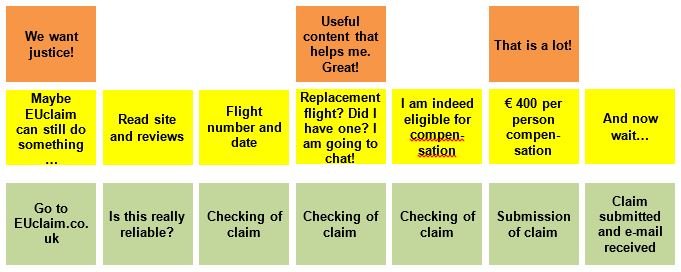
Since the wizard is such an essential part of the customer experience, it is continuously tested to improve usability. This leads to even better visitor numbers as well as a decrease in the number of visitor queries about using the wizard.
The rest of the customer journey consists of being kept up-to-date with regard to the progress, and the determination of the settlement amount, followed by the actual settlement and a request to write a short review about the experience with EUclaim. A very high number of customers then write a positive review about both the service they received as well as the results that were achieved.
The Customer Journey and The Online Improvements
The customer journey that has been set up has had a major influence on the EUclaim website as well as the A/B tests.
The EUclaim website was revamped at the beginning of the year. It needed a more modern and fresh look, but the real aim was to increase customer satisfaction. That is why a number of things were simultaneously changed at the time. These included a better implementation of the Trustpilot reviews.
Setting up a good landing page was also especially important. When people land on the flight delayed page, there are two key questions that have to be answered:
- What are the rights of delayed passengers?
- Does compensation apply to my case?
Such matters were addressed in the new design and also further optimized at a later stage through A/B testing.
A/B testing is an important method for improving usability, with further improvements being dependent on an extensive test plan with hypotheses. Chat was for instance one option to increase customer satisfaction. An A/B test on customer behavior with and without chat provided us with an answer about whether or not we should implement it: visitors appreciate chat as a channel and are therefore more likely to submit a claim. It offers real time clarification to those nagging last-minute queries and help ease customer anxieties. With a live chat option, the customer is unlikely to bounce off looking for answers elsewhere.
Other tests look at the need for information and what aspects regarding the compensation need to be explained.
Visibility is a key factor when trying to attract visitors to EUclaim. This is extremely important especially in Google search. Attention is therefore paid to PR (offine), SEO and AdWords. An important point in empowering customers then is to provide visible and actionable direction for travelers. In order to achieve this, EUclaim also publishes press releases about the most delayed flights and blogs (on their own website) about relevant legislation and the circumstances that are eligible to win a compensation.
Why This Customer Journey
A detailed customer journey reveals many interesting areas for improvement. The question is whether or not the above improvements could also have been identified without a customer journey. The answer is, yes, it is possible. Many roads lead to Rome.
I do find a customer journey an enjoyable way of working, because it provides so much insight into the perspective of the customer, the processes customers undertake, and the emotions they evoke. It provides very meaningful information in a structured manner. In the online realm the customer journey involves advertising, UBRs (unique buying reasons) that are relevant at that exact moment, information written on the website, contact information and programming on the website (the wizard).
Therefore, even when a customer journey is only being applied to the online channel, it provides an enormous amount of benefits. I think the investment of time necessary to conduct one is definitely worth it.
For those who have not yet created a customer journey or are looking for more information about the basics of it, this is a good hands-on presentation about customer experience and setting up a customer journey.
So, have you set up a customer journey yet? If not, has this post pushed you an inch closer to doing it? If you don’t agree with us on this, please write to us at [email protected]!
As always, we are listening.




